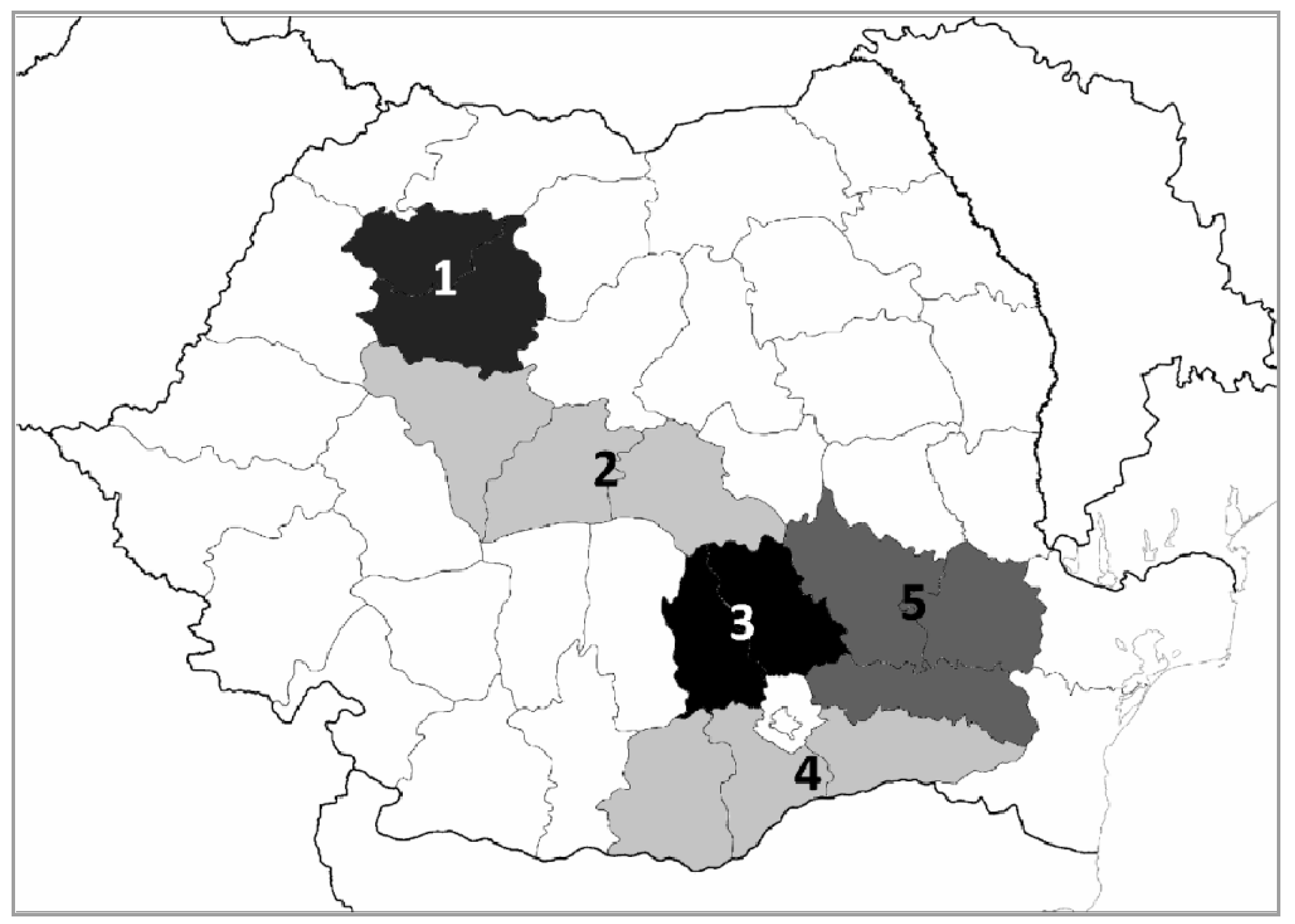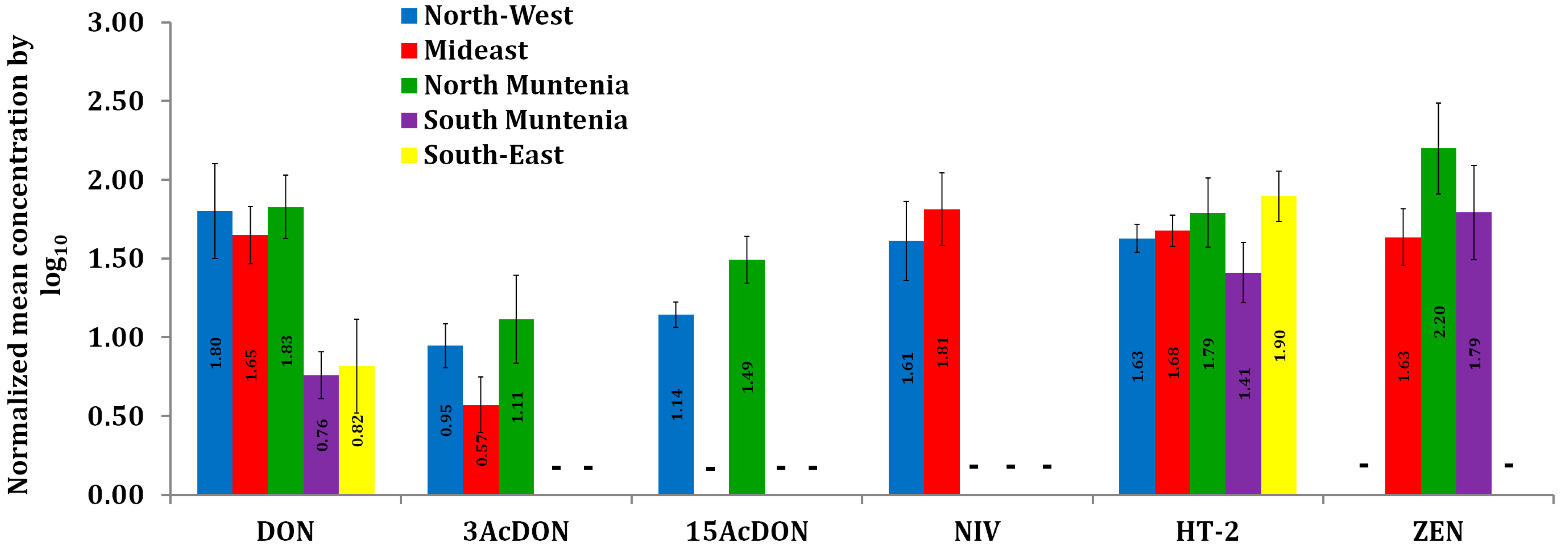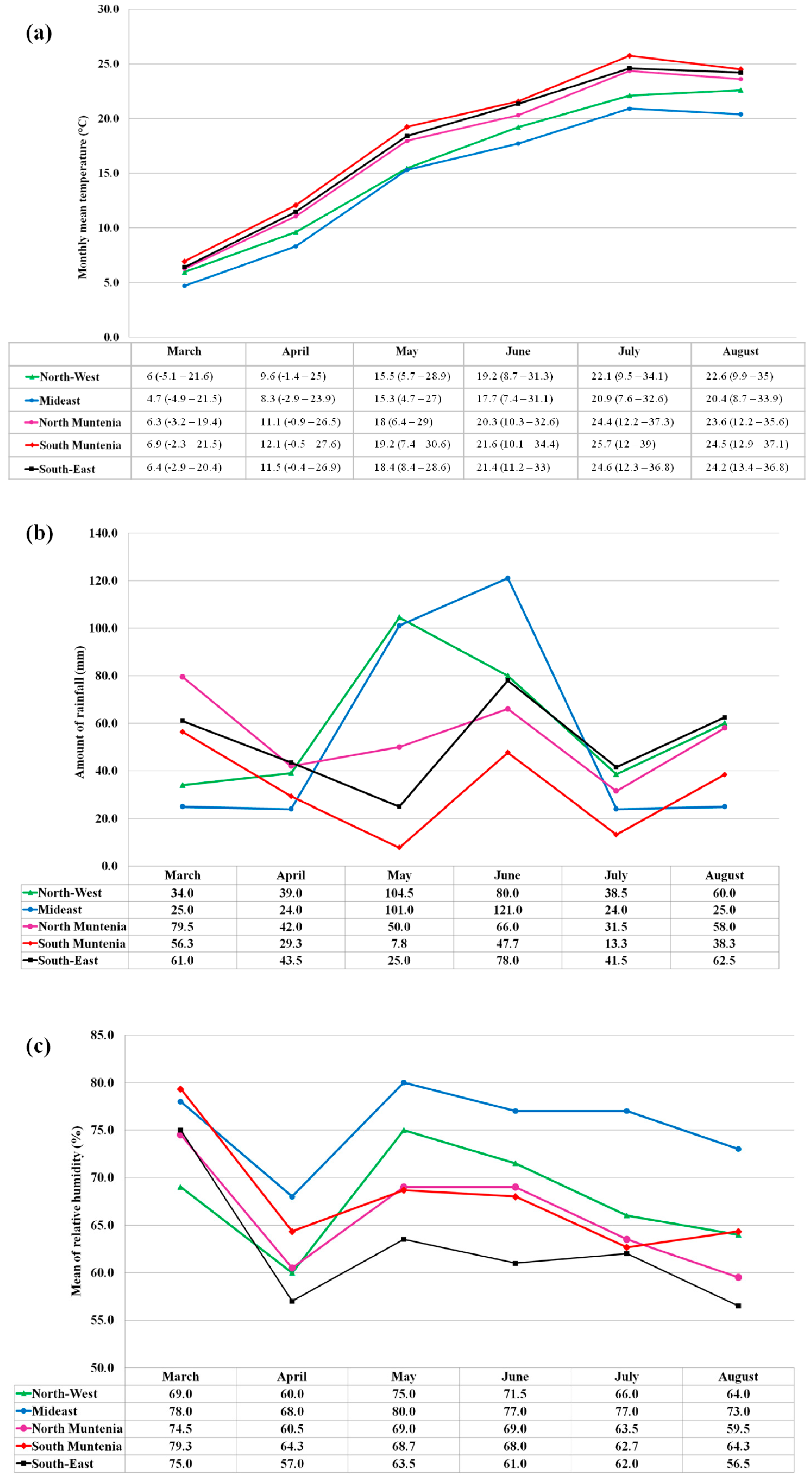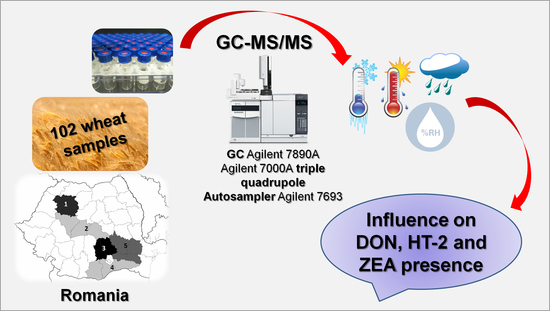Study on Trichothecene and Zearalenone Presence in Romanian Wheat Relative to Weather Conditions
Abstract
1. Introduction
2. Results
2.1. Method Validation and Performance
2.2. Mycotoxin Occurrence Data in Romanian Wheat During 2015
2.3. Climate Influence
3. Conclusions
4. Materials and Methods
4.1. Chemicals and Reagents
4.2. Sampling
4.3. Sample Preparation
4.3.1. Extraction
4.3.2. Derivatisation
4.4. GC-QqQ-MS/MS
4.5. Method Validation
4.6. Climate Conditions
4.7. Statistical Analysis of the Data
Author Contributions
Funding
Acknowledgments
Conflicts of Interest
References
- Schmidt, M.; Horstmann, S.; De Colli, L.; Danaher, M.; Speer, K.; Zannini, E.; Arendt, E.K. Impact of fungal contamination of wheat on grain quality criteria. J. Cereal Sci. 2016, 69, 95–103. [Google Scholar] [CrossRef]
- Food and Agriculture Organization of the United Nations Statistic Division. FAOSTAT. Download Data. Food Balance. Food Supply- Crops Primary Equivalent. Available online: http://faostat3.fao.org/download/FB/CC/E (accessed on 11 November 2018).
- Lenc, L. Fusarium head blight (FHB) and Fusarium populations in grain of winter wheat grown in different cultivation systems. J. Plant Prot. Res. 2015, 55, 94–109. [Google Scholar] [CrossRef]
- Wegulo, S.N.; Baenziger, P.S.; Hernandez Nopsa, J.; Bockus, W.W.; Hallen-Adams, H. Management of Fusarium head blight of wheat and barley. Crop Prot. 2015, 73, 100–107. [Google Scholar] [CrossRef]
- McCormick, S.P.; Stanley, A.M.; Stover, N.A.; Alexander, N.J. Trichothecenes: From simple to complex mycotoxins. Toxins 2011, 3, 802–814. [Google Scholar] [CrossRef]
- Terzi, V.; Tumino, G.; Stanca, A.M.; Morcia, C. Reducing the incidence of cereal head infection and mycotoxins in small grain cereal species. J. Cereal Sci. 2014, 59, 284–293. [Google Scholar] [CrossRef]
- Stanciu, O.; Banc, R.; Cozma, A.; Filip, L.; Miere, D.; Mañes, J.; Loghin, F. Occurence of Fusarium mycotoxins in wheat from Europe—A review. Acta Univ. Cibiniensis Ser. E Food Technol. 2015, 19, 35–60. [Google Scholar] [CrossRef]
- IARC. Some Naturally Occurring Substances: Food Items and Constituents, Heterocyclic Aromatic Amines and Mycotoxins. In IARC (International Agency for Research on Cancer) Monographs on the Evaluation of Carcinogenic Risk of Chemicals to Humans; IARC: Geneve, Switzerland, 1993; Volume 56, pp. 489–521. [Google Scholar]
- Ruiz, M.-J.; Macáková, P.; Juan-García, A.; Font, G. Cytotoxic effects of mycotoxin combinations in mammalian kidney cells. Food Chem. Toxicol. 2011, 49, 2718–2724. [Google Scholar] [CrossRef] [PubMed]
- De Ruyck, K.; De Boevre, M.; Huybrechts, I.; De Saeger, S. Dietary mycotoxins, co-exposure, and carcinogenesis in humans: Short review. Mutat. Res. 2015, 766, 32–41. [Google Scholar] [CrossRef]
- Chilaka, C.; De Boevre, M.; Atanda, O.; De Saeger, S. The Status of Fusarium Mycotoxins in Sub-Saharan Africa: A Review of Emerging Trends and Post-Harvest Mitigation Strategies towards Food Control. Toxins 2017, 9, 19. [Google Scholar] [CrossRef]
- Viegas, S.; Assunção, R.; Nunes, C.; Osteresch, B.; Twarużek, M.; Kosicki, R.; Grajewski, J.; Martins, C.; Alvito, P.; Almeida, A.; et al. Exposure Assessment to Mycotoxins in a Portuguese Fresh Bread Dough Company by Using a Multi-Biomarker Approach. Toxins 2018, 10, 342. [Google Scholar] [CrossRef]
- Moretti, A.; Pascale, M.; Logrieco, A.F. Mycotoxin risks under a climate change scenario in Europe. Trends Food Sci. Technol. 2018, 84, 38–40. [Google Scholar] [CrossRef]
- Paterson, R.R.M.; Lima, N. Further mycotoxin effects from climate change. Food Res. Int. 2011, 44, 2555–2566. [Google Scholar] [CrossRef]
- Van der Fels-Klerx, H.J.; Liu, C.; Battilani, P. Modelling climate change impacts on mycotoxin contamination. World Mycotoxin J. 2016, 9, 717–726. [Google Scholar] [CrossRef]
- Dumitrescu, A.; Birsan, M.V. ROCADA: A gridded daily climatic dataset over Romania (1961–2013) for nine meteorological variables. Nat. Hazards 2015, 78, 1045–1063. [Google Scholar] [CrossRef]
- Gagiu, V.; Doja, L.; Mateescu, E.; Smeu, I.; Cucu, M.E.; Dobre, A.A.; Oprea, O.; Iorga, E.; Nastasia, B. Contamination with Deoxynivalenol in the Milling- Bakery Industry Under the Influence of Climatic Conditions From Romania. J. Hyg. Eng. Des. 2016, 16, 38–44. [Google Scholar]
- Palacios, S.A.; Erazo, J.G.; Ciasca, B.; Lattanzio, V.M.T.; Reynoso, M.M.; Farnochi, M.C.; Torres, A.M. Occurrence of deoxynivalenol and deoxynivalenol-3-glucoside in durum wheat from Argentina. Food Chem. 2017, 230, 728–734. [Google Scholar] [CrossRef]
- Ferrigo, D.; Raiola, A.; Causin, R. Fusarium toxins in cereals: Occurrence, legislation, factors promoting the appearance and their management. Molecules 2016, 21, 627. [Google Scholar] [CrossRef] [PubMed]
- Kos, J.; Hajnal, E.J.; Šarić, B.; Jovanov, P.; Nedeljković, N.; Milovanović, I.; Krulj, J. The influence of climate conditions on the occurrence of deoxynivalenol in maize harvested in Serbia during 2013–2015. Food Control 2017, 73, 734–740. [Google Scholar] [CrossRef]
- Nation Institute of Statistics. Romanian Statistical Yearbook 2015; National Institute of Statistics: Bucharest, Romania, 2016.
- Breidbach, A. A greener, quick and comprehensive extraction approach for LC-MS of multiple mycotoxins. Toxins 2017, 9, 91. [Google Scholar] [CrossRef] [PubMed]
- European Commission. Commission Regulation (EC) No 1881/2006 of 19 December 2006 setting maximum levels for certain contaminants in foodstuffs. Off. J. Eur. Union 2006, L364, 5–24. [Google Scholar]
- Galbenu-Morvay, P.L.; Trif, A.; Damiescu, L.; Simion, G. T-2 Toxin Occurrence in Cereals and Cereal- Based Foods. Bull. UASVM Agric. 2011, 68, 274–280. [Google Scholar]
- Macri, A.M.; Miclăuş, V.; Dancea, Z.; Morar, M.V.; Paşca, I.; Scurtu, I.; Szakacs, A.; Rus, V. Zearalenone and trichothecene content of maize and wheat samples coming from center and western Romania. Ann. RSCB 2009, 14, 315–318. [Google Scholar]
- Stanciu, O.; Juan, C.; Miere, D.; Loghin, F.; Mañes, J. Occurrence and co-occurrence of Fusarium mycotoxins in wheat grains and wheat flour from Romania. Food Control 2017, 73, 147–155. [Google Scholar] [CrossRef]
- Gagiu, V.; Mateescu, E.; Smeu, I.; Dobre, A.A.; Cucu, M.E.; Oprea, O.A.; Iorga, E.; Belc, N. A survey of the cereal contamination with deoxynivalenol in Romania, for 2011–2013 period. Rom. Biotechnol. Lett. 2017, 22, 12240–12249. [Google Scholar]
- European Commission. Commission Recommendation (EU) on the presence of T-2 and HT-2 toxin in cereals and cereal products. Off. J. Eur. Union 2013, 9, 12–15. [Google Scholar]
- Banu, I.; Aprodu, I.; Nicolau, A.I. Occurrence of Fusarium mycotoxins (deoxynivalenol and zearalenone) in wheat and high fibre wheat bread in Eastern Romania. J. Environ. Prot. Ecol. 2011, 12, 519–525. [Google Scholar]
- Stroia, C.; Tabuc, C.; Neacsu, A. Incidence of Fusarium Species and Its Mycotoxins in Cereals From Western Romania. Res. J. Agric. Sci. 2010, 42, 302–309. [Google Scholar]
- Galbenu, P.; Damiescu, L.; Trif, A. Zearalenone occurrence in cereal and cereal-based foodstuffs marked in Timis county. Res. J. Agric. Sci. 2011, 43, 43–49. [Google Scholar]
- Alexa, E.; Dehelean, C.A.; Poiana, M.-A.; Radulov, I.; Cimpean, A.-M.; Bordean, D.-M.; Tulcan, C.; Pop, G. The occurrence of mycotoxins in wheat from western Romania and histopathological impact as effect of feed intake. Chem. Cent. J. 2013, 7, 99. [Google Scholar] [CrossRef] [PubMed]
- Mişcă, C.; Damiescu, L.; Jianu, C.; David, I.; Mişcă, L.; Mărginean, O.; Rădoi, B.; Rinovetz, A.; Bujancă, G.; Velciov, A.; et al. the Incidence of the Strains of Fusarium sp. and of Zearalenone in Cereals Analyzed From the South West of Romania. Ann. West Univ. Timis. Ser. Biol. 2014, 17, 137–144. [Google Scholar]
- Bryła, M.; Waśkiewicz, A.; Podolska, G.; Szymczyk, K.; Jędrzejczak, R.; Damaziak, K.; Sułek, A. Occurrence of 26 Mycotoxins in the Grain of Cereals Cultivated in Poland. Toxins 2016, 8, 160. [Google Scholar] [CrossRef] [PubMed]
- Juan, C.; Covarelli, L.; Beccari, G.; Colasante, V.; Mañes, J. Simultaneous analysis of twenty-six mycotoxins in durum wheat grain from Italy. Food Control 2016, 62, 322–329. [Google Scholar] [CrossRef]
- Vogelgsang, S.; Musa, T.; Bänziger, I.; Kägi, A.; Bucheli, T.D.; Wettstein, F.E.; Pasquali, M.; Forrer, H.R. Fusarium mycotoxins in Swiss wheat: A survey of growers’ samples between 2007 and 2014 shows strong year and minor geographic effects. Toxins 2017, 9, 246. [Google Scholar] [CrossRef] [PubMed]
- The Romanian National Meteorological Administration. Available online: http://www.meteoromania.ro/anm/?page_id=2279 (accessed on 4 November 2018).
- Gagiu, V.; Mateescu, E.; Armeanu, I.; Dobre, A.A.; Smeu, I.; Cucu, M.E.; Oprea, O.A.; Iorga, E.; Belc, N. Post-Harvest Contamination with Mycotoxins in the Context of the Geographic and Agroclimatic Conditions in Romania. Toxins 2018, 10, 533. [Google Scholar] [CrossRef]
- Škrbić, B.; Malachova, A.; Živančev, J.; Veprikova, Z.; Hajšlová, J. Fusarium mycotoxins in wheat samples harvested in Serbia: A preliminary survey. Food Control 2011, 22, 1261–1267. [Google Scholar] [CrossRef]
- Bryła, M.; Ksieniewicz-Woźniak, E.; Waśkiewicz, A.; Szymczyk, K.; Jędrzejczak, R. Natural Occurrence of Nivalenol, Deoxynivalenol, and Deoxynivalenol-3-Glucoside in Polish Winter Wheat. Toxins 2018, 10, 81. [Google Scholar] [CrossRef] [PubMed]
- Alkadri, D.; Rubert, J.; Prodi, A.; Pisi, A.; Mañes, J.; Soler, C. Natural co-occurrence of mycotoxins in wheat grains from Italy and Syria. Food Chem. 2014, 157, 111–118. [Google Scholar] [CrossRef]
- Dweba, C.C.; Figlan, S.; Shimelis, H.A.; Motaung, T.E.; Sydenham, S.; Mwadzingeni, L.; Tsilo, T.J. Fusarium head blight of wheat: Pathogenesis and control strategies. Crop Prot. 2017, 91, 114–122. [Google Scholar] [CrossRef]
- Chilaka, C.A.; De Boevre, M.; Atanda, O.O.; De Saeger, S. Fate of Fusarium mycotoxins during processing of Nigerian traditional infant foods (ogi and soybean powder). Food Res. Int. 2018, 116, 408–418. [Google Scholar] [CrossRef]
- Pascari, X.; Ramos, A.J.; Marín, S.; Sanchís, V. Mycotoxins and beer. Impact of beer production process on mycotoxin contamination. A review. Food Res. Int. 2018, 103, 121–129. [Google Scholar] [CrossRef]
- Paterson, R.R.M.; Venâncio, A.; Lima, N.; Guilloux-Bénatier, M.; Rousseaux, S. Predominant mycotoxins, mycotoxigenic fungi and climate change related to wine. Food Res. Int. 2018, 103, 478–491. [Google Scholar] [CrossRef] [PubMed]
- Edwards, S.G.; Kharbikar, L.L.; Dickin, E.T.; MacDonald, S.; Scudamore, K.A. Impact of pre-harvest rainfall on the distribution of fusarium mycotoxins in wheat mill fractions. Food Control 2018, 89, 150–156. [Google Scholar] [CrossRef]
- European Commission. Commission Regulation (EC) No 401/2006 of 23 February 2006 laying down the methods of sampling and analysis for the official control of the levels of mycotoxins in foodstuffs. Off. J. Eur. Union 2006, L70, 12–34. [Google Scholar]
- European Commission. Commission Decision of 12 August 2002 implementing Council Directive 96/23/EC concerning the performance of analytical methods and the interpretation of results. Off. J. Eur. Communities 2002, L221, 8–36. [Google Scholar]



| Analyte | Rt (min) | SRM (Selection Reaction Monitoring) Transitions (m/z) | CE (eV) | Dt (ms) | LOD (μg kg−1) | LOQ (μg kg−1) | Recovery (RSD) (%) | ME ± RSD (%) | Linearity (r2) | |||||
|---|---|---|---|---|---|---|---|---|---|---|---|---|---|---|
| LOQ | 2 LOQ | 10 LOQ | ||||||||||||
| DON | 8.45 | 392 > 259 Q | 10 | 25 | 0.5 | 1 | 100 | (7) | 95 | (1) | 127 | (2) | 85 ± 9 | 0.994 |
| 407 > 197 q | 10 | 25 | ||||||||||||
| 3AcDON | 9.45 | 392 > 287 Q | 10 | 25 | 1.25 | 2.5 | 84 | (17) | 85 | (4) | 117 | (15) | 133 ± 7 | 0.995 |
| 467 > 147 q | 5 | 35 | ||||||||||||
| 15AcDON | 9.65 | 392 > 217 Q | 20 | 35 | 2.5 | 5 | 87 | (1) | 82 | (6) | 108 | (11) | 102 ± 6 | 0.996 |
| 392 > 184 q | 20 | 35 | ||||||||||||
| FUS-X | 9.55 | 450 > 26 Q | 10 | 35 | 2.5 | 5 | 79 | (4) | 73 | (3) | 97 | (7) | 137 ± 4 | 0.998 |
| 450 > 245 q | 20 | 35 | ||||||||||||
| DAS | 9.56 | 350 > 229 Q | 15 | 35 | 7.5 | 15 | 83 | (16) | 77 | (11) | 118 | (10) | 66 ± 6 | 0.989 |
| 378 > 124 q | 10 | 25 | ||||||||||||
| NIV | 9.90 | 289 > 73 Q | 15 | 35 | 10 | 20 | 78 | (3) | 88 | (1) | 117 | (5) | 97 ± 9 | 0.994 |
| 379 > 73 q | 15 | 35 | ||||||||||||
| NEO | 11.30 | 252 > 195 Q | 10 | 25 | 10 | 20 | 75 | (4) | 80 | (1) | 86 | (9) | 129 ± 3 | 0.999 |
| 252 > 167 q | 15 | 35 | ||||||||||||
| HT-2 | 14.40 | 347 > 185 Q | 10 | 25 | 7.5 | 15 | 100 | (19) | 84 | (5) | 84 | (7) | 111 ± 6 | 0.989 |
| 347 > 157 q | 10 | 25 | ||||||||||||
| T-2 | 14.45 | 350 > 229 Q | 10 | 25 | 2.5 | 5 | 103 | (1) | 107 | (1) | 113 | (5) | 101 ± 1 | 0.989 |
| 350 > 259 q | 15 | 35 | ||||||||||||
| ZEN | 15.46 | 462 > 151 Q | 20 | 25 | 5 | 10 | 69 | (8) | 106 | (8) | 97 | (3) | 64 ± 4 | 0.999 |
| 462 > 333 q | 20 | 25 | ||||||||||||
| Region | Parameter | Mycotoxin | Co-Occurrence | ||||||
|---|---|---|---|---|---|---|---|---|---|
| DON | 3AcDON | 15AcDON | NIV | HT-2 | ZEN | (%) | Combinations (Number of Samples) | ||
| North-West (n = 9) | Frequency (%) | 100 | 22 | 22 | 11 | 11 | 11 | 3/9 (33) | DON + 3AcDON + 15AcDON (2) |
| Mean (μg kg−1) | 62.4 | 7.83 | 12.9 | 40 | 41.5 | n.q. | DON + NIV + HT-2 + ZEN (1) | ||
| Range (μg kg−1) | 2.3–323 | 7.83 | 8.9–16.9 | 40 | 41.5 | n.q. | |||
| Mideast (n = 9) | Frequency (%) | 89 | 22 | 11 | 22 | 33 | 33 | 5/9 (56) | DON + ZEN (1) |
| Mean (μg kg−1) | 43.5 | 2.7 | n.q. | 63.8 | 46.4 | 42.1 | DON + HT-2 (1) | ||
| Range (μg kg−1) | 1.3–129 | 2.72 | n.q. | 63.3–64.3 | 35.2–67.4 | 23.8–77.7 | DON + NIV + HT-2 (1) | ||
| DON + 3AcDON + 15AcDON + ZEN (1) | |||||||||
| DON + 3AcDON + NIV+HT-2 + ZEN (1) | |||||||||
| North Muntenia (n = 31) | Frequency (%) | 68 | 3 | 6 | 0 | 10 | 16 | 7/31 (23) | DON + ZEN (3) |
| Mean (μg kg−1) | 66.3 | 12 | 30 | n.q. | 60.8 | 157 | DON + HT-2 (2) | ||
| Range (μg kg−1) | 1.1–955 | 12 | 30 | n.q. | 31.1–98.5 | 12.4–300 | DON + 15AcDON + HT-2 (1) | ||
| DON + 3AcDON + 15AcDON + ZEN (1) | |||||||||
| South Muntenia (n = 37) | Frequency (%) | 43 | 0 | 0 | 0 | 8 | 19 | 4/37 (11) | DON + ZEN (3) |
| Mean (μg kg−1) | 4.7 | n.q. | n.q. | n.q. | 24.7 | 60.9 | DON + HT-2 (1) | ||
| Range (μg kg−1) | 1.2–16.4 | n.q. | n.q. | n.q. | 24.7 | 11.7–155 | |||
| South-East (n = 16) | Frequency (%) | 38 | 0 | 0 | 0 | 6 | 0 | 0/16 (0) | - |
| Mean (μg kg−1) | 5.5 | n.q. | n.q. | n.q. | 77.6 | n.q. | |||
| Range (μg kg−1) | 1.1–11 | n.q. | n.q. | n.q. | 77.6 | n.q. | |||
| Overall (n = 102) | Incidence | 60 | 5 | 5 | 3 | 11 | 16 | 19/102 (19) | DON + ZEN (7) |
| LOD–LOQ | 11 | 2 | 2 | 0 | 2 | 5 | DON + HT-2 (4) | ||
| Frequency (%) | 59 | 5 | 5 | 3 | 11 | 16 | DON + 3AcDON + 15AcDON (2) | ||
| Mean (μg kg−1) | 44.3 | 7.5 | 18.6 | 55.9 | 51.7 | 90.7 | DON + 15AcDON + HT-2 (1) | ||
| Range (μg kg−1) | 1.1–955 | 2.7–12 | 8.9–30 | 40–64.3 | 24.7–98.5 | 11.7–300 | DON + NIV + HT-2 (1) | ||
| ML (μg kg−1) | 1750 | n.a. | n.a. | n.a. | 100 * | 100 | DON + 3AcDON + 15AcDON + ZEN (2) | ||
| DON + NIV + HT-2 + ZEN (1) | |||||||||
| DON + 3AcDON + NIV + HT-2 + ZEN (1) | |||||||||
| Year | Method | Mycotoxins | LOD (μg kg−1) | N | Frequency (%) | Range (μg kg−1) | Ref. |
|---|---|---|---|---|---|---|---|
| n.a. | GC/MS | DON | n.a. | 42 | 90 | 21–3395 | [25] |
| 15AcDON | 36 | 6–99 | |||||
| NIV | 2 | max. 30 | |||||
| DAS | 2 | max. 19 | |||||
| HT-2 | 50 | 3–18 | |||||
| T-2 | 2 | max. 7 | |||||
| 2008 | ELISA | DON | n.a. | 40 | 43 | max. 95.7 | [29] |
| ZEN | 10 | max. 5.5 | |||||
| 2009 | ELISA | DON | n.a. | 12 | 83 | 6.1–154.3 | [30] |
| ZEN | 50 | 36.7–67.3 | |||||
| 2009 | ELISA | T-2 | n.a. | 2 | 100 | 0.8–1.0 | [24] |
| 2008–2010 | ELISA | ZEN | n.a. | 20 | 10 | 0.88–3.6 | [31] |
| 2010 | ELISA | DON | 110 | 26 | 73 | 294–3390 | [32] |
| ZEN | 22.7 | 69 | 37.6–1000 | ||||
| 2011 | ELISA | DON | 110 | 26 | 19 | 254–1440 | [32] |
| ZEN | 22.7 | 77 | 28–105.6 | ||||
| 2012 | ELISA | DON | 18.5 | 831 | 65 | <18.5–5027 | [27] |
| 2013 | ELISA | DON | 18.5 | 923 | 53 | <18.5–3602 | [27] |
| 2014 | ELISA | ZEN | n.a. | 336 | 5 | 17–80 | [33] |
| 2014 | LC-MS/MS | DON | 20 | 31 | 26 | 110–1787 | [26] |
| 3AcDON | 20 | 0 | n.q. | ||||
| 15AcDON | 150 | 0 | n.q. | ||||
| NIV | 150 | 0 | n.q. | ||||
| DAS | 30 | 0 | n.q. | ||||
| NEO | 7 | 0 | n.q. | ||||
| HT-2 | 50 | 0 | n.q. | ||||
| T-2 | 75 | 0 | n.q. | ||||
| ZEN | 20 | 13 | 327–1135 | ||||
| 2015 | ELISA | DON | 18.5 | 4 | 50 | <18.5–964 | [17] |
© 2019 by the authors. Licensee MDPI, Basel, Switzerland. This article is an open access article distributed under the terms and conditions of the Creative Commons Attribution (CC BY) license (http://creativecommons.org/licenses/by/4.0/).
Share and Cite
Stanciu, O.; Juan, C.; Berrada, H.; Miere, D.; Loghin, F.; Mañes, J. Study on Trichothecene and Zearalenone Presence in Romanian Wheat Relative to Weather Conditions. Toxins 2019, 11, 163. https://doi.org/10.3390/toxins11030163
Stanciu O, Juan C, Berrada H, Miere D, Loghin F, Mañes J. Study on Trichothecene and Zearalenone Presence in Romanian Wheat Relative to Weather Conditions. Toxins. 2019; 11(3):163. https://doi.org/10.3390/toxins11030163
Chicago/Turabian StyleStanciu, Oana, Cristina Juan, Houda Berrada, Doina Miere, Felicia Loghin, and Jordi Mañes. 2019. "Study on Trichothecene and Zearalenone Presence in Romanian Wheat Relative to Weather Conditions" Toxins 11, no. 3: 163. https://doi.org/10.3390/toxins11030163
APA StyleStanciu, O., Juan, C., Berrada, H., Miere, D., Loghin, F., & Mañes, J. (2019). Study on Trichothecene and Zearalenone Presence in Romanian Wheat Relative to Weather Conditions. Toxins, 11(3), 163. https://doi.org/10.3390/toxins11030163







